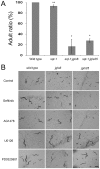An in vivo C. elegans model system for screening EGFR-inhibiting anti-cancer drugs
- PMID: 22957020
- PMCID: PMC3434183
- DOI: 10.1371/journal.pone.0042441
An in vivo C. elegans model system for screening EGFR-inhibiting anti-cancer drugs
Abstract
The epidermal growth factor receptor (EGFR) is a well-established target for cancer treatment. EGFR tyrosine kinase (TK) inhibitors, such as gefinitib and erlotinib, have been developed as anti-cancer drugs. Although non-small cell lung carcinoma with an activating EGFR mutation, L858R, responds well to gefinitib and erlotinib, tumors with a doubly mutated EGFR, T790M-L858R, acquire resistance to these drugs. The C. elegans EGFR homolog LET-23 and its downstream signaling pathway have been studied extensively to provide insight into regulatory mechanisms conserved from C. elegans to humans. To develop an in vivo screening system for potential cancer drugs targeting specific EGFR mutants, we expressed three LET-23 chimeras in which the TK domain was replaced with either the human wild-type TK domain (LET-23::hEGFR-TK), a TK domain with the L858R mutation (LET-23::hEGFR-TK[L858R]), or a TK domain with the T790M-L858R mutations (LET-23::hEGFR-TK[T790M-L858R]) in C. elegans vulval cells using the let-23 promoter. The wild-type hEGFR-TK chimeric protein rescued the let-23 mutant phenotype, and the activating mutant hEGFR-TK chimeras induced a multivulva (Muv) phenotype in a wild-type C. elegans background. The anti-cancer drugs gefitinib and erlotinib suppressed the Muv phenotype in LET-23::hEGFR-TK[L858R]-expressing transgenic animals, but not in LET-23::hEGFR-TK[T790M-L858R] transgenic animals. As a pilot screen, 8,960 small chemicals were tested for Muv suppression, and AG1478 (an EGFR-TK inhibitor) and U0126 (a MEK inhibitor) were identified as potential inhibitors of EGFR-mediated biological function. In conclusion, transgenic C. elegans expressing chimeric LET-23::hEGFR-TK proteins are a model system that can be used in mutation-specific screens for new anti-cancer drugs.
Conflict of interest statement
Figures





References
-
- Artal-Sanz M, de Jong L, Tavernarakis N (2006) Caenorhabditis elegans: a versatile platform for drug discovery. Biotechnol J 1: 1405–1418. - PubMed
-
- Hynes NE, Lane HA (2005) ERBB receptors and cancer: the complexity of targeted inhibitors. Nat Rev Cancer 5: 341–354. - PubMed
-
- Gschwind A, Fischer OM, Ullrich A (2004) The discovery of receptor tyrosine kinases: targets for cancer therapy. Nat Rev Cancer 4: 361–370. - PubMed
-
- Muhsin M, Graham J, Kirkpatrick P (2003) Gefitinib. Nat Rev Drug Discov 2: 515–516. - PubMed
Publication types
MeSH terms
Substances
Grants and funding
LinkOut - more resources
Full Text Sources
Research Materials
Miscellaneous

